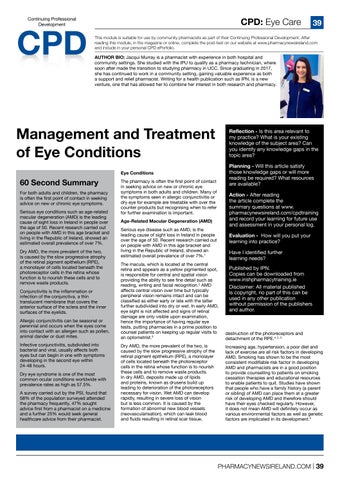CPD: Eye Care
Continuing Professional Development
CPD
39
This module is suitable for use by community pharmacists as part of their Continuing Professional Development. After reading this module, in the magazine or online, complete the post-test on our website at www.pharmacynewsireland.com and include in your personal CPD ePorfolio.
AUTHOR BIO: Jacqui Murray is a pharmacist with experience in both hospital and community settings. She studied with the IPU to qualify as a pharmacy technician, where soon after made the transition to studying pharmacy in UCC. Since graduating in 2017, she has continued to work in a community setting, gaining valuable experience as both a support and relief pharmacist. Writing for a health publication such as IPN, is a new venture, one that has allowed her to combine her interest in both research and pharmacy.
Management and Treatment of Eye Conditions
Reflection - Is this area relevant to my practice? What is your existing knowledge of the subject area? Can you identify any knowledge gaps in the topic area? Planning - Will this article satisfy those knowledge gaps or will more reading be required? What resources are available?
Eye Conditions
60 Second Summary For both adults and children, the pharmacy is often the first point of contact in seeking advice on new or chronic eye symptoms. Serious eye conditions such as age-related macular degeneration (AMD) is the leading cause of sight loss in Ireland in people over the age of 50. Recent research carried out on people with AMD in this age bracket and living in the Republic of Ireland, showed an estimated overall prevalence of over 7%. Dry AMD, the more prevalent of the two, is caused by the slow progressive atrophy of the retinal pigment epithelium (RPE), a monolayer of cells located beneath the photoreceptor cells in the retina whose function is to nourish these cells and to remove waste products. Conjunctivitis is the inflammation or infection of the conjunctiva, a thin translucent membrane that covers the anterior surface of the sclera and the inner surfaces of the eyelids. Allergic conjunctivitis can be seasonal or perennial and occurs when the eyes come into contact with an allergen such as pollen, animal dander or dust mites. Infective conjunctivitis, subdivided into bacterial and viral, usually affects both eyes but can begin in one with symptoms developing in the second eye within 24-48 hours. Dry eye syndrome is one of the most common ocular conditions worldwide with prevalence rates as high as 57.5%. A survey carried out by the PSI, found that 58% of the population surveyed attended the pharmacy frequently, 47% sought advice first from a pharmacist on a medicine and a further 25% would seek general healthcare advice from their pharmacist.
The pharmacy is often the first point of contact in seeking advice on new or chronic eye symptoms in both adults and children. Many of the symptoms seen in allergic conjunctivitis or dry eye for example are treatable with over the counter products but recognising when to refer for further examination is important.
Action - After reading the article complete the summary questions at www. pharmacynewsireland.com/cpdtraining and record your learning for future use and assessment in your personal log.
Age-Related Macular Degeneration (AMD) Serious eye disease such as AMD, is the leading cause of sight loss in Ireland in people over the age of 50. Recent research carried out on people with AMD in this age bracket and living in the Republic of Ireland, showed an estimated overall prevalence of over 7%.1
Evaluation - How will you put your learning into practice? Have I identified further learning needs?
The macula, which is located at the central retina and appears as a yellow pigmented spot, is responsible for central and spatial vision providing the ability to see fine detail such as reading, writing and facial recognition.2 AMD affects central vision over time but typically peripheral vision remains intact and can be classified as either early or late with the latter further subdivided into dry or wet. In early AMD, eye sight is not affected and signs of retinal damage are only visible upon examination, hence the importance of having regular eye tests, putting pharmacies in a prime position to counsel patients on keeping up regular visits to an optometrist.3
destruction of the photoreceptors and detachment of the RPE.4, 2, 3
Dry AMD, the more prevalent of the two, is caused by the slow progressive atrophy of the retinal pigment epithelium (RPE), a monolayer of cells located beneath the photoreceptor cells in the retina whose function is to nourish these cells and to remove waste products. In dry AMD, deposits made up of lipids and proteins, known as drusens build up leading to deterioration of the photoreceptors necessary for vision. Wet AMD can develop rapidly, resulting in severe loss of vision but is less common. It is caused by the formation of abnormal new blood vessels (neovascularisation), which can leak blood and fluids resulting in retinal scar tissue,
Increasing age, hypertension, a poor diet and lack of exercise are all risk factors in developing AMD. Smoking has shown to be the most consistent modifiable risk factor in developing AMD and pharmacists are in a good position to provide counselling to patients on smoking cessation therapies and educational resources to enable patients to quit. Studies have shown that people who have a family history (a parent or sibling) of AMD can place them at a greater risk of developing AMD and therefore should have their eyes checked regularly. However, it does not mean AMD will definitely occur as various environmental factors as well as genetic factors are implicated in its development.5
Published by IPN. Copies can be downloaded from www.irishpharmacytraining.ie Disclaimer: All material published is copyright, no part of this can be used in any other publication without permission of the publishers and author.
PHARMACYNEWSIRELAND.COM | 39



